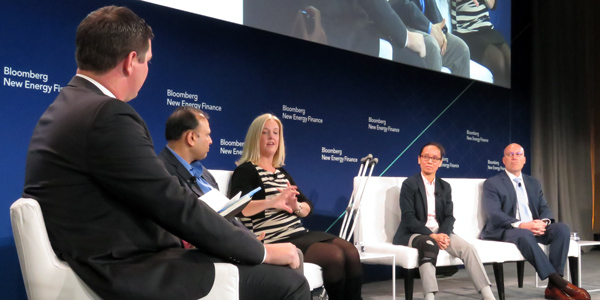By Rich Heidorn Jr.
NEW YORK — Solar industry officials last week expressed confidence that the sector will continue to grow despite the Trump administration’s tariffs on imported solar cells and modules. But they told Bloomberg New Energy Finance’s Future of Energy Summit that the levies have hurt in the short term.
“They were more of a punch to the gut than a complete decapitation, which is what we feared,” said Abigail Hopper, CEO of the Solar Energy Industries Association. “And so, while they will certainly have a dampening effect on the industry — and I think we’ll see that for years — I feel fairly confident that it will continue to grow.”
“It certainly slowed things down. We were seeing a slowing of project flow,” said Scott Wiater, CEO of Standard Solar, which provides financing and management of utility-scale solar projects. “But recently we’ve seen it start to pick up tremendously. I think a lot of developers have been sitting on projects, waiting for the tariff decision and tax [legislation] to settle down. [There was also] some seasonality thrown in there. And now we’re really starting to see it ramp back up.
“I do think in some states where it’s a difficult environment [to operate] it may have iced the markets. But in states that are solar-friendly, I think we’re going to hit the ground running.”
Vikram Aggarwal, CEO of EnergySage, which provides a portal for homeowners researching pre-screened rooftop PV installers, agreed that the impact has varied by geography. Aggarwal said a survey of his company’s installers indicated two-thirds planned to absorb all or most of the cost increases, with one-third saying they would pass most of the increases to consumers.
“It actually seems like it’s playing out that way. … We’re seeing prices roughly 1% down on a national basis compared to last year. In certain markets like California, the prices are actually down quite a bit. In markets that are less developed, less mature, prices are trending up. It’s a tale of two cities.”
Aggarwal said consumers have not been scared away by the tariffs. “The consumer interest is actually very strong this quarter. We’re running about 150 to 200% above year-over-year.”
Wiater said he has no fear of higher prices squelching consumer interest. “I think we may have an oversupply situation coming very quickly and prices could come down below what … analysts are expecting very quickly.”
Hopper said the tariff debate brought it new conservative allies in D.C., with the American Legislative Exchange Council (ALEC), the Heritage Foundation and R Street Group joining SEIA in opposing the levies.
Portrayals of the solar industry as split over the tariff debate were inaccurate, she said. “It really was two companies [who filed the complaint that prompted the tariffs] against 1,000 others.” She said about 20 solar companies have reported the loss of jobs or investments. “It is serious and harmful,” she said. (See Tariff to Pinch US Solar Growth; Factory Surge Unlikely.)
The solar industry lost 10,000 jobs (3.8%) last year, dropping to 250,271, according to the Solar Foundation’s National Solar Jobs Census. It was the first year-over-year drop in employment, said Hugh Bromley, head of U.S. solar for BNEF, who moderated the discussion.
Even so, 29 states added solar jobs. The prospects of job growth has helped open doors for the industry, Hopper said.
“In terms of electricity generation, solar creates more jobs than all fossil fuels combined, which is an incredible statistic that now more people in Washington know,” she said. “One of the great outcomes [of the tariff case] was we did so much education among all these brand new policymakers in Washington. And when we talk about the amount of jobs, and the jobs in relation to other industries and other fuel sources, that was always a point on which I felt like we’re getting traction. Because we’re now talking about jobs in lots and lots of red states.”








